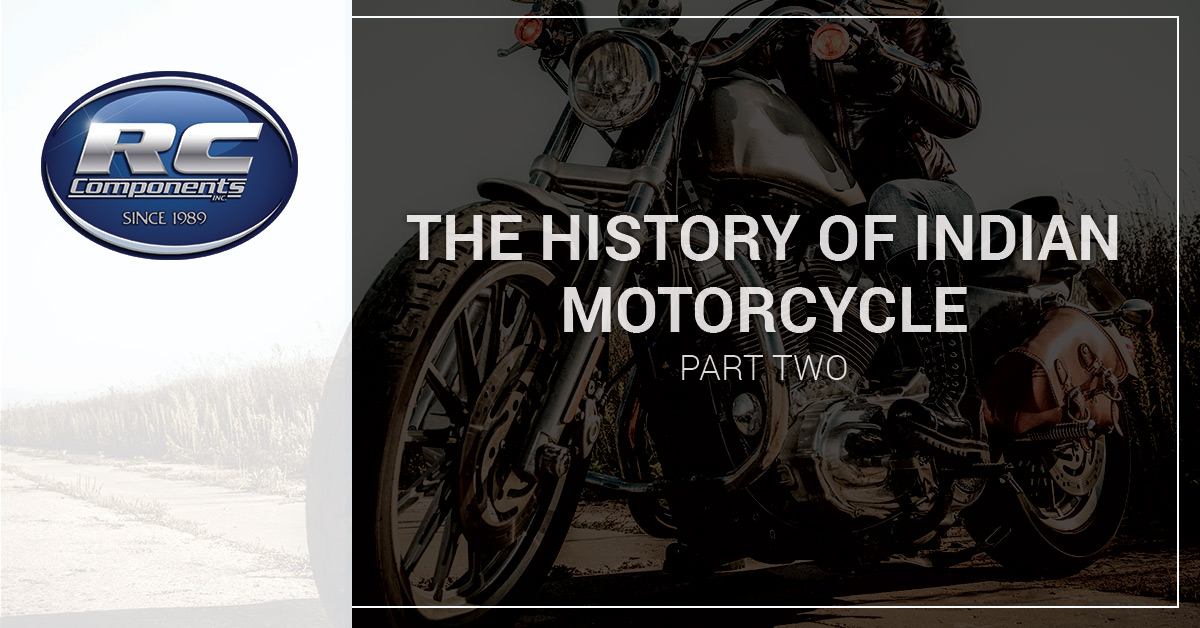The History of Indian Motorcycle: Part 2
Jan 16th 2018

If you’re a motorcycle enthusiast, you should know a bit of the history behind today’s most popular motorcycle manufacturers. If you’re a Harley-Davidson enthusiast, be sure to check out our series on the history of-Harley Davidson motorcycles! Indian Motorcycle is the focus of our current series, and in our last blog, we introduced you to George Hendee and Oscar Hedstrom, the two men who founded Indian Motorcycle. In today’s post, we’ll be looking at the slightly turbulent history of Indian Motorcycle from roughly 1903 until 1916.
RC components is your go-to online retailer for aftermarket motorcycle wheels, exhaust pipes, and a variety of aftermarket motorcycle modifications. From forged wheels to slip-ons for the Indian Scout, RC Components carries everything you need to customize your Indian bike – browse our inventory online today, and don’t hesitate to contact us with questions!
Achievements and Records
1902 was a big year for Indian Motorcycle, as the first models had just become available to the public. The demand for Indian motorcycles was increasing, and their motorcycles were also being used in a number of competitions around the United States. Indian Motorcycle went on to win several endurance races over the next several years, including a race that began in New York City, went all the way to Springfield, Illinois and then all the way back to New York City! In 1903, an Indian motorcycle set a new world record by reaching an unprecedented speed of 56 miles per hour.

While Harley-Davidson is known for its V-twin engine, Indian Motorcycle actually developed and installed the V-twin engine into its motorcycles three years before Harley-Davidson. The popularity of Indian motorcycles was growing, and the company relocated to Springfield in 1907 with a larger factory and workforce. Indian Motorcycle began improving on its designs, and the company gained notoriety primarily by winning races and breaking records.
Hedstrom continued thinking of ways to improve the efficiency and manufacturing capabilities of the factory, and in 1910, he created the blueprints for an additional five stories of manufacturing space. Construction on the new additions was completed in 1912, and the payoff was enormous. The very next year, Indian Motorcycle proudly announced that they had reached a company, record-smashing number of 32,000 motorcycles sold in a single year! Though motorcycles had been growing in popularity, the American Motorcycle Association reports that the introduction of the Model T into the American automotive market contributed to a decline in the company’s profits.
Leadership Changes
Oscar Hedstrom decided to leave Indian Motorcycle in 1913, apparently due to irreconcilable differences of opinion with the company’s board of directors. In 1915, Hendee decided to retire as Indian Motorcycle’s general manager, though he wished to remain the president of the company. His decision to remain the president of the company did not last long, however, and he retired from his position the very next year at the age of 49. In his retirement, Hendee volunteered with several different organizations and raised cattle on his farm in Connecticut with his wife. Hendee passed away in 1943 in Suffield, Connecticut, at the age of 79. He will be forever remembered as an icon of American manufacturing.
While Hendee’s retirement was certainly a milestone in the history of the company, Indian Motorcycle’s success was only just beginning. We hope that you’ve enjoyed this adventure into the beginnings of Indian Motorcycle. Stay tuned for the next post in our series, in which we will look at the role of Indian Motorcycle in World Wars I and II. RC Components is proud to provide aftermarket motorcycle wheels, exhaust pipes, and more! From Harley-Davidson aftermarket wheels to Indian Motorcycle mufflers, we have it all! Browse our catalog online today!

